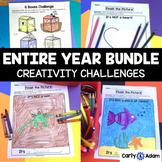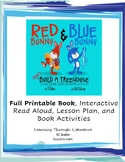98 results
Middle school critical thinking algebra dbqs

The Sinking of the Lusitania: Solve the WWI Mystery w Primary Source Analysis!
Perhaps one of the most important events of World War One, the sinking of the Lusitania has fascinated kids and adults for years. Use this mystery to harness that fascination and engage students in an inquiry-based mission that they will remember all year long!In this mystery, students are posed with an engaging scenario - they are CIA Agents that must piece together once and for all how and why the Lusitania sank. They are presented with a variety of "exhibits," all cleverly designed to engage
Grades:
5th - 12th
Types:
Also included in: GROWING WWI BUNDLE: Higher Order Thinking WWI Activities (SS5H2)
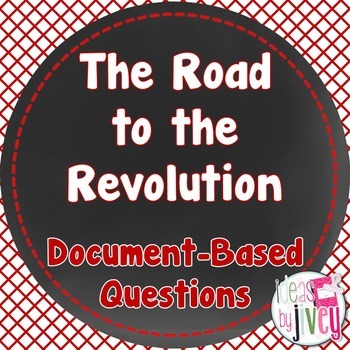
Road to the American Revolution DBQ Document-Based Questions
American RevolutionDocument-Based Questions (DBQs) are a great way to expose students to primary sources as well as to make them think about an event in history and respond to it. This unit can be used in a few ways. You can project the full-page images on my board so that we can discuss them, and then the students answer the DBQ in their notebooks. I have also included the DBQs in printable format so that your students can answer on paper and digital Google Forms that you can send electronicall
Grades:
4th - 6th
Types:
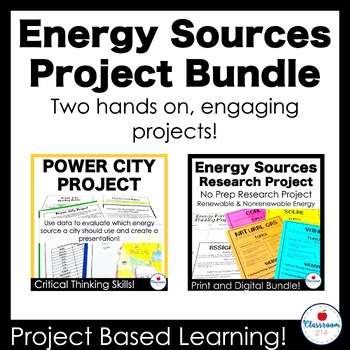
Renewable and Nonrenewable Energy Sources Project Bundle
Two dynamic renewable and nonrenewable energy sources projects. Student will apply research skills to learn about renewable and nonrenewable energy sources and then apply their knowledge to help a fictional community decide which two energy sources are best for their town. These projects put students in charge of their learning and keep them motivated with real life scenarios while improving their critical thinking, persuasive writing, and public speaking skills, and research skills. Minimal p
Subjects:
Grades:
5th - 8th
Types:
NGSS:
MS-ESS3-1
, MS-ESS3-4
, MS-ESS3-3
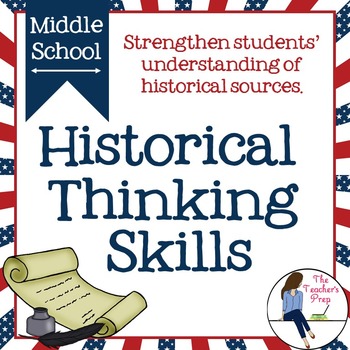
Historical Thinking Skills Activities
Historical thinking is a key skill for students to utilize when examining primary and secondary sources. In order for students to fully understand a source, they must examine it in-depth. These activities are designed to strengthen student's understanding of historical sources. They can be used with any type of historical document.
The Historical Thinking Skills Activities includes:
***Teacher Resources***
1. What is Historical Thinking (A letter for the teacher)
2. Think and Link – the step
Grades:
5th - 8th
Types:

Slavery in the Southern Colonies: A Socratic Seminar
Looking for a higher order thinking activity? Need a way to close out a unit on the Southern Colonies? Do you want to do a Socratic Seminar with your students? Students will evaluate three primary source documents to answer document-based questions. Students will engage in higher-level thinking and improve listening and speaking skills during this common-core supported activity. This activity is appropriate for 5th-7th graders and meets the Common Core Standards for Speaking and Listening.
If
Grades:
5th - 8th
Types:
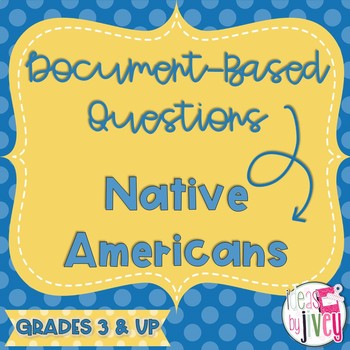
Native Americans DBQ Document-Based Questions
Native AmericansDocument-Based Questions (DBQs) are a great way to expose students to primary sources as well as to make them think about an event in history and respond to it. This unit can be used in a few ways. You can project the full-page images on my board so that we can discuss them, and then the students answer the DBQ in their notebooks. I have also included the DBQs in printable format so that your students can answer on paper and digital Google Forms that you can send electronically.
Grades:
3rd - 6th
Types:
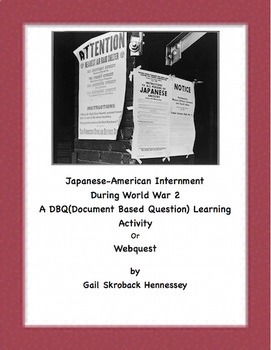
DBQ: Life of a Japanese-American Child Living in an Internment Camp during WW2)
Using PRIMARY Sources in the Classroom. A DBQ activity uses primary sources. Sources can include diaries,posters, music, news articles from the time, anything written by those who participated in or witnessed an event in history. Students review the given documents and use many cognitive skills in processing what they see and read. After gathering information using the documents, students develop an essay answering a question. The topic of this Primary Source(DBQ )is Life of a Japanese-American
Grades:
5th - 8th
Types:
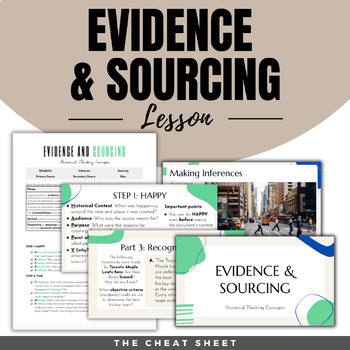
Evidence and Sourcing Lesson: Teaching Historical Thinking - Digital & Print!
This engaging lesson focuses on the Historical Thinking Concept of EVIDENCE AND SOURCING. Students will develop their historical thinking and critical analysis skills, including the following:Making inferencesPrimary vs Secondary SourcesRecognizing Bias and Reliability of sourcesSourcing historical documents using the HAPPY TIME sourcing methodAnalyzing several primary and secondary source documentsThis lesson includes the following materials:Detailed lesson planGoogle slides with big question,
Grades:
7th - 12th, Higher Education, Adult Education
Also included in: Historical Thinking Bundle: A Complete Unit - Digital & Print!

Analyzing Renaissance Art: Primary Source Activity
Students will build their understanding of primary sources as they collaborate to analyze five key pieces of Renaissance art to better understand its themes and concepts. A great way to introduce the Renaissance, wrap up the chapter, buffer some time between your last bit of notes and the test, close out Friday or liven up Monday, this student-centered, collaborative, and engaging activity will have you covered. Slides are included to allow for a full class discussion and formative assessmen
Subjects:
Grades:
6th - 12th
CCSS:
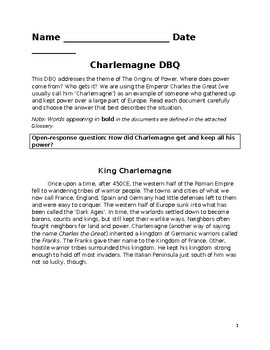
Charlemagne DBQ
This DBQ addresses the theme of The Origins of Power. Where does power come from? Who gets it? We are using the Emperor Charles the Great (usually called ‘Charlemagne’ in the English world) as an example of someone who gathered up and kept power over a large part of Europe. Students are challenged to read primary documents carefully and choose the answer that best describes the situation.
We begin by setting the stage with a very brief synopsis of Western Rome falling. The Germanic tr
Grades:
8th - 11th

Nazi Germany - how did Hitler and the Nazis indoctrinate children DBQ
This lesson is designed too help students understand why Hitler and the Nazi Party tried to indoctrinate young people and children in their beliefs. It then aims to explain how the Nazi Party did this.The lesson contains:- Two document/source based starter activities.- Worksheet of Primary sources and information on the HItler youth.- Extensive questions on the sources.- Essay planning sheet answering the question "To what extent did the Nazi party use fear to indoctrinate children into the
Grades:
8th - 11th
Also included in: NAZI GERMANY HISTORY BUNDLE
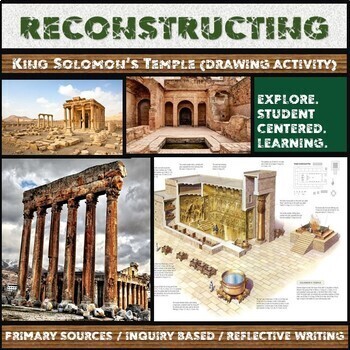
Reconstructing Solomon's Temple (Drawing Activity)
A fun activity that plays to a wide variety of strengths, skill sets and interests. Students will investigate different examples and elements of Phoenician architecture as well as primary source accounts before creating a reasonable sketch of King Solomon's Temple. I have used this with my world history students during the unit on ancient Israel and found that it makes a good research and analysis lesson, and allows for students to have the freedom to explore and draw reasonable conclusions.
Grades:
6th - 12th
Types:
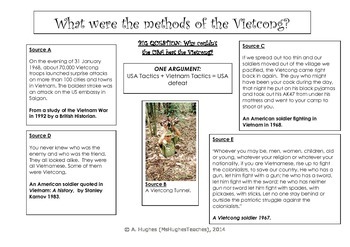
What were the methods of the Vietcong during the Vietnam War? DBQ
This worksheet uses contemporary sources to investigate the different methods used by the Vietcong fighters during the Vietnam war. The focus is on the Guerrilla tactics and the American GI's reactions to them. Students have to be able to infer from the sources to get a fuller picture of the methods used by the Vietnamese.I use this lesson as part of several on the methods of the Vietcong AND the methods of the American troops to help explain why America was unable to win the war.Students have
Subjects:
Grades:
8th - 12th
Types:
Also included in: Vietnam War History GROWING BUNDLE
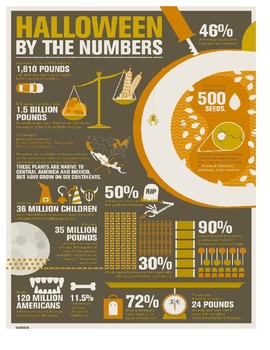
Halloween Infographic Analysis
Students analyze data from 10 different infographics about Halloween. I plan to lay out the 10 infographics around the room and let students rotate through the different stations. You could also upload the infographics to an online learning page, like Schoology, and have students answer the questions from the computer. *Note: the printers at my school do not print in color. All of the questions students will be able to answer without the colors on the graphs.
Subjects:
Grades:
8th - 12th
Types:
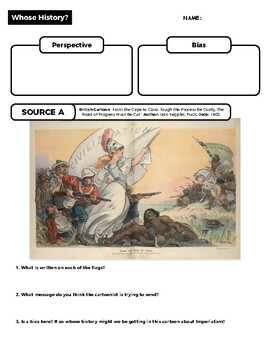
Whose History? - Cartoon Analysis: Bias and Perspective in Imperialist Cartoons
This lesson explores the role perspective and bias play in shaping history. Using primary sources, students are prepared to identity bias in political cartoons created during the height of European imperialism. In particular students will explore the ways in which racial and cultural biases sought to justify European imperialism. In the case of studying imperialism, the brutal reality of colonization is often ignored or justified by the racial and cultural biases of European historians. This mat
Grades:
8th - 10th
Types:
CCSS:
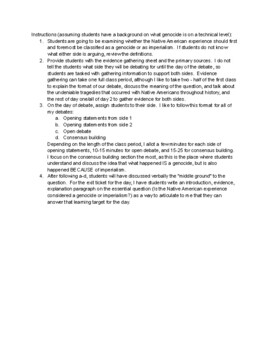
Native American Genocide Structured Academic Controversy
With this structured academic controversy, students critically examine Native American history to answer the question: Should the Native American experience be considered a genocide or imperialism? Students scrutinize primary sources of events that happened, debate the essential question, and find the middle ground with this multi-day lesson.
Grades:
7th - 10th
Types:

The White House is On Fire - War of 1812 (Teaching Literacy Through History)
In 1814, the British set fire to the White House. The tale of Dolley Madison rescuing the Gilbert Stuart portrait of George Washington is well-known because she wrote an account of it herself. Paul Jennings, a slave at Madison’s Montpelier plantation, also wrote a firsthand account. This lesson provides an opportunity for students to compare/contrast the two accounts and answer the essential questions of "What happens when there are two contradictory eye-witness accounts of the same historica
Grades:
4th - 7th
Types:
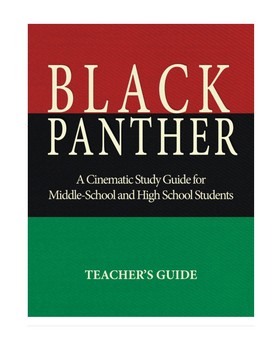
Black Panther: A Cinematic Study Guide for Middle/ High School-Teacher's Guide
In this guide students will critically discuss and write about, the iconic movie Black Panther, including looking at its historical, social and cultural impact.
At least one viewing of the movie is necessary, although at least two viewings is recommended, may be necessary to be able to converse with other students. All the written questions are based on the student seeing the movie. In fact, you may review the writing process sheets with the students before assigning a writing prompt. Extensio
Grades:
7th - 12th, Higher Education, Adult Education

8th Grade U.S. History - Entire Year of Supplemental Materials!
This bundle includes note taking prompts, content vocabulary, critical thinking questions, essay prompts, activities, study guides, and assessments for an entire year of 8th grade Social Studies. This is supplementary to the text History Alive! The U.S. Through Industrialism, but could be used for any junior high U.S. History curriculum.
Grades:
8th
Types:
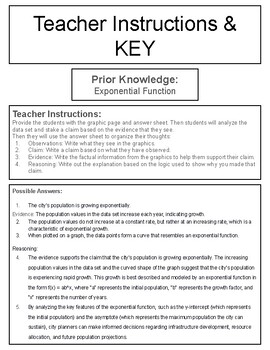
Exponential Function C.E.R.
This C.E.R. focuses on using data from an exponential function in a real-world scenario and being able to justify how and why it works.Teacher Instructions:Provide the students with the graphic page and answer sheet. Then students will analyze the data set and stake a claim based on the evidence that they see.Then they will use the answer sheet to organize their thoughts: Observations: Write what they see in the graphics. Claim: Write a claim based on what they have observed. Evidence: Write the
Grades:
7th - 12th
CCSS:

Socratic Seminar Guide for Teachers (Common Core)
**Updated**
Socratic Seminar have so many benefits for students and developing their critical thinking skills.
Includes assessment ideas for seminar.
Use this easy guide to help get you started with using Socratic Seminars within your classroom. I have used seminars for all subject areas and use this guide for staff professional development as well as introducing to my students.
This is a word document, so you can change to meet your classroom needs.
**If you love it, please give it 4 star
Grades:
4th - 12th
Types:
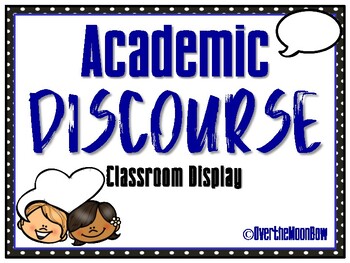
Academic Discourse | Accountable Talk Display | Black Polka Dot w/ Blue
This eye-catching, black polka dot style academic discourse display will help your students engage in meaningful conversations about text and content learning. It’s a great visual support for increased rigor, and meeting standards and academic expectations! Includes:· 15-Academic Discourse Sentence Stems· 4-Matching Header Choices (with & without speech bubble)· Student-size Bookmarks (choice of 4 headers)Be sure to check out my other Learning Strategy Displays, more coming soon!
Grades:
K - 6th
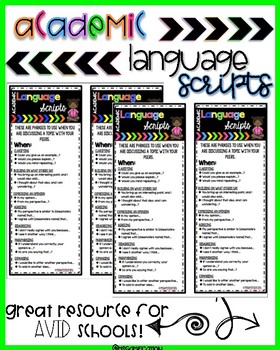
Elementary ELA AVID Academic Language Scripts Classroom Discussion Printables
*** New Seller please follow, comment, and review if you like these! <3*** These Academic Language Scripts are perfect in an AVID classroom setting. It is used to build classroom discussion and improve how students respond to each other during discussion. These are used as questions stems to add to discussion during socratic seminar or philosophical chairs. *Available in two colors brights and primary colors Socratic SeminarPhilosophical ChairsClassroom Discussion Literature Circles Promotin
Subjects:
Grades:
2nd - 12th
Types:
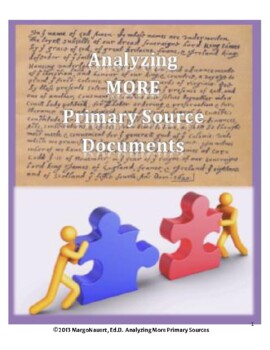
Analyzing MORE Primary Sources
Analyzing MORE Primary Sources takes off where Analyzing Primary Sources leaves off. Make primary source documents manageable for upper elementary and middle school students with this collection of 10 graphic organizers based on known strategies as well as 21 primary source documents based on 7 engaging topics for students. Through the use of organizers designed to break apart independent sources, students will be able to complete a comparison chart on which they will analyze the purpose of the
Grades:
3rd - 9th
Types:
Showing 1-24 of 98 results

